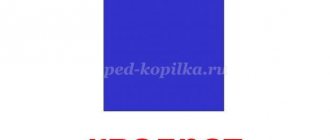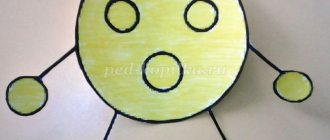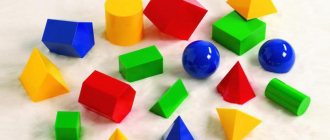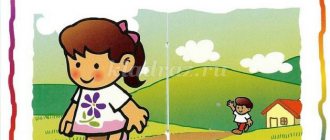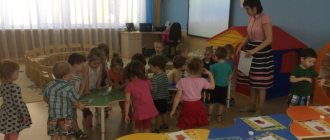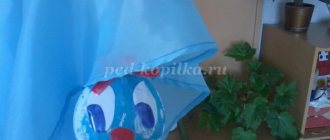Summary of an open lesson on FEMP in the first junior group “Geometric Figures”
The teacher suggests tracing a circle with your finger.
Educator: Let's look further:
- I have three tops, three corners, three sides. Who am I?
Children: Triangle.
He takes out a triangle and attaches it next to the circle: “What else did the Bunny bring us? What is the name of this figure?
The teacher invites the children to repeat the name of the figure in chorus, and for some children to show its sides and angles.
Educator: Well done! And here is another figure:
“I’m not an oval, I’m not a circle, I’m not a friend to a triangle,
This is the kind of brother I am.
And my name is...
Children: Square.
Then he takes out a square, places it next to the triangle, names the figure, shows the sides and corners of the square and asks the children: “What does a square have? How many sides does a square have? How many angles does a square have?
The teacher asks the children to circle the square and show its sides (corners).
The teacher summarizes the children's answers and actions.
part 2
. Educator: “What great fellows you all are. They correctly named all the geometric shapes that Bunny brought. I think he really enjoyed being with you, and he offers to warm up a little.
Physical school
The little gray bunny sits and wiggles his ears!
(Children squat down and use their hands to imitate how a bunny moves its ears)
Just like that, like that, and he moves his ears!
It's cold for the bunny to sit, we need to warm his little paws,
That's it, that's it, we need to warm our little paws!
(Children lightly clap palm to palm, then stand up)
It's cold for the bunny to stand, the bunny needs to jump!
Hop - hop - hop - hop, the bunny needs to jump!
(Children jump on two legs, pressing their hands to their chest)
Someone scared the bunny, the bunny jumped and ran away.
(The children scatter in all directions, and the teacher takes the fox and runs after the bunnies)
Educator: - Well done! The bunny told me that in our group there are a lot of objects that have the same shape as his gifts - a circle, a square, a triangle. And he offers to find them.
Look, under each of you there is a card with a picture of a circle, square, triangle. Take them and look at them. Then look carefully at our group and find something round, square, triangular.
(Children, in accordance with the image on the card, find the necessary objects of round, square, triangular shape.)
Educator: Well done, you also coped with this task.
Part 3.
Outdoor game "Find your house."
There is a circle, a triangle and a square on the tables. Children take one geometric figure that was under their chairs and call them the keys to the house (hoop). Children with keys go to the carpet and begin to move to the music. At the end of the melody, the teacher says that it is night and they must find their houses: those with a circle in their hands run to the circle, those with a triangle run to the triangle, those with a square run to the square. When the children take their places, the teacher asks them to justify their choice.
Mathematics lesson in 1st junior group. Circle and square
Summary of a lesson on the formation of elementary mathematical concepts in the 1st junior group.
Topic: Geometric figures: circle and square Purpose: to consolidate ideas about geometric figures - circle and square. Objectives: Educational:
- teach to recognize, distinguish and find geometric shapes: circle and square;
- learn to correlate a geometric figure with its model; - teach children to navigate in space, use prepositions -under, -for, -7na Developmental:
- develop attention;
- develop the ability to analyze and work with didactic material Educational:
- cultivate interest in joint activities with peers;
- develop a sense of community; - cultivate a sense of empathy for the characters Speech:
- development of coherent speech - teach children to answer the question “how much?”
the word "a lot"; - use of words in speech: circle, square, round shape, square shape. Preliminary work: • Reading fiction “Zayushkina’s Hut” • D/i “Geometric Figures” • Games “Fox and Hares” • Finger gymnastics “House” Developing subject-spatial environment: Dienesh blocks (circles and squares of different sizes and colors), 2 houses, pictures with square and round objects, toys: a fox and a hare, a circle and a square made of cardboard.
Progress:
Chairs on the carpet in a semicircle.
Educator: Children, sit down on the chairs. The back was straightened, the arms were placed on the knees. There's a knock on the door. Educator: Guys, who is that knocking? I'll go open the door. (I take the hare and fox toys) That's who knocked on our door! Did you find out? Children: Yes, it's the fox and the hare. Educator: Where do you think they came to us from? Children: from the forest. Educator: Do you remember the fairy tale about the fox and the hare? Children: Yes, Zayushka’s hut. The fox kicked the bunny out of the house because her hut had melted. Educator: Correct. But now the fox and the hare have become friends, the fox promised not to offend the bunny anymore. Today they came to visit us so that the children could help them build houses. Let's help the animals? Children: Yes! Educator: Let's get down to work together and build new houses for the fox and the hare. And let them “walk” around our group. Finger gymnastics All day long knock and knock - a ringing sound is heard (hands clenched into fists, thumb raised up, tapping on the index finger) Hammers knock (knock fist on fist) We build a house for the animals. This is such a good house. How wonderful we will live! (show “roof”) Educator: These are the kind of houses we got! Where are our little animals? Let's go look for them. Are they near the closet? Children: No Teacher: Is there something under the table? Children: No! Jr. At this time, the teacher scatters Dienesh blocks in the form of a path on the floor. Educator: That's where they are! They hid behind the sofa! Dana, where are the little animals hiding? Children: Behind the sofa. (I ask 3-4 children) Educator: Fox, bunny, we built houses for you, let’s go have a look. Oh, there's a blockage on our way. How will we get to the house?! To go further, we need to clear the road. Guys, these are not ordinary stones. Look what shape they are? What geometric shapes do they resemble? Children: circle and square. Educator: Well done! Let's clear the path of stones. We will put all the round pebbles on the round “stump”, and square-shaped pebbles on the square “stump”. What shape of pebble did you take? Why did you put it here? (2-3 children) Good guys, everyone did it! Because we worked together, because together it turns out faster and better: everyone managed to arrange the pebbles into shape. Look! These are houses. But they are different. What is painted on this house? Children: circle Teacher: And in the other house? Children: square Educator: How can we now understand who gets which house? Look, the animals have badges. What shape is the fox's badge? Children: square Teacher: What about the bunny? Children: round Teacher: Well done! Now we know where whose house is. Let's plant them next to our houses. Bunny, your house is round. What should we say to the fox? “Fox, your house is square.” Let's visit each other together. And you, kids, sit down on the chairs. Guys, there is nothing in the houses of the fox and the hare. How to be? We need to help them arrange their huts. Are you ready to help? Children: Yes Educator: I have pictures, but they are not simple. Some objects on them are round, and some are square. What do you think we should put in the fox’s house? What shape? Children: square Teacher: What shape of objects should we put in the house for the bunny? Children: Round. Educator: Why? Children: Because the bunny has a round icon. I suggest going to the table and taking 1 picture. Ask the children: “What is shown in the picture? What shape? Who needs to be put in the house?” Educator: Well done. You were able to determine the shape of objects in the pictures. The animals became cheerful and happy! Because their house is no longer empty, it has many items that they need every day. They thank you for their new homes, for being able to furnish them, and invite you to play with them and celebrate their housewarming. Outdoor game “Fox and Hares”
We leave the animals in the houses, say goodbye to them
Teacher, Children: Goodbye, fox and bunny! All the best to you!
We recommend watching:
Summary of GCD in the 1st junior group on FEMP “Let's treat the Bunny with a carrot” Summary of GCD in the 1st junior group on the formation of a holistic picture of the world Summary of a design lesson in the 1st junior group Summary of a lesson with children of the first junior group
Similar articles:
Summary of GCD in the 1st junior group by February 23
Lesson notes for the early childhood group in kindergarten
Lesson summary for an early age group. Cockerel
Lesson summary for an early age group. Dandelion
Summary of a game development lesson in kindergarten in the second group of early age on the topic: Toys
Long-term planning for cognitive development (FEMP) in the first junior group (2–3 years old)
Olga Azimova
Long-term planning for cognitive development (FEMP) in the first junior group (2–3 years old)
Long-term planning for cognitive development (FEMP) in the first junior group (2 – 3 years old)
Planning was compiled in accordance with the program “From birth to school” edited by N. E. Veraksa, T. S. Komarova, M. A. Vasilyeva.
Used Books.
I. A. Pomoraeva “Formation of elementary mathematical concepts”, second group of early age.
month of September
Lesson 1
Subject:
"Ball in the Basket"
Program content:
Development of objective actions.
Develop mindfulness.
Cultivate perseverance.
Literature:
I. A. Pomoraeva s. 10 z. 1
Lesson 2
Subject:
"Ball in the Basket" (continued)
Program content:
Development of objective actions.
Develop thinking.
Cultivate interest in the game
Literature:
I. A. Pomoraeva s. 10 z. 2
Lesson 3
Subject:
"Wand-play"
Program content:
Development of objective actions.
Develop spatial orientation skills.
Cultivate a feeling of sympathy for each other.
Literature:
I. A. Pomoraeva s. 10 z. 3
Lesson 4
Subject:
“Wand-toy” (continued)
Program content:
Development of objective actions.
Develop curiosity.
Cultivate positive relationships with peers.
Literature:
I. A. Pomoraeva s. 10 z. 4
October month
Lesson 5
Subject:
“What rolls, what doesn’t roll”
Program content:
Formation of the ability to distinguish objects by shape and name them: cube, ball. Forming the ability to perform actions with objects: tracing the shape of an object, rolling it, placing it.
Develop analytical skills.
Cultivate volitional efforts.
Literature:
I. A. Pomoraeva s. 11 z. 1
Lesson 6
Subject:
“Hide the cube, hide the ball”
Program content:
Formation of the ability to distinguish objects by shape and name them: cube, ball. Forming the ability to perform actions with objects: trace the shape of an object with your palm, roll it, place it.
Develop the ability to compare.
Cultivate the desire to act purposefully.
Literature:
I. A. Pomoraeva s. 12 z. 2
Lesson 7
Subject:
"Find the same one"
Program content:
Formation of the ability to distinguish objects by shape and name them: brick, ball. Formation of the ability to perform actions with objects: stroke with the palm of your hand, roll, place, build simple buildings.
Develop the ability to relate.
Cultivate the desire to overcome difficulties.
Literature:
I. A. Pomoraeva s. 12 z. 3
Lesson 8
Subject:
“Building chairs for nesting dolls”
Program content:
Formation of the ability to distinguish objects by shape and name them: cube, ball. Developing the ability to construct simple buildings.
Develop grouping skills.
Cultivate the desire to see things through to the end.
Literature:
I. A. Pomoraeva s. 13 z. 4
Lesson 9
Subject:
"What's in the bag?"
Program content:
Formation of the ability to distinguish objects by shape and name them: cube, ball, brick.
Develop the ability to establish identity.
Cultivate discipline.
Literature:
I. A. Pomoraeva s. 14 z. 1
November month
Lesson 10
Subject:
“Gathering toys for a walk”
Program content:
Development of the ability to distinguish objects of contrasting sizes and designate them with words: large, small.
Develop the ability to establish the difference between homogeneous objects based on one of the sensory attributes.
Develop the ability to listen to a friend.
Literature:
I. A. Pomoraeva s. 15 z. 2
Lesson 11
Subject:
"Round dance of nesting dolls"
Program content:
Development of the ability to distinguish objects of contrasting sizes and designate them with words: large, small. Improving subject actions.
Develop attention and memory.
Develop the ability to listen to the teacher.
Literature:
I. A. Pomoraeva s. 15 z. 3
Lesson 12
Subject:
"Building turrets"
Program content:
Development of the ability to distinguish cubes of contrasting size and name them: large cubes, small cubes. Developing the ability to construct simple buildings.
Develop auditory attention.
Cultivate accuracy in completing tasks.
Literature:
I. A. Pomoraeva s. 16 z. 4
December month
Lesson 13
Subject:
"Let's roll the balls along the paths"
Program content:
Development of the ability to distinguish cubes of contrasting size and name them: large cubes, small cubes.
Improving subject actions.
Develop attention.
Cultivate patience.
Literature:
I. A. Pomoraeva s. 17 z. 1
Lesson 14
Subject:
"Toys for Dolls"
Program content:
Development of the ability to distinguish cubes and balls of contrasting sizes.
Formation of the ability to group objects by size.
Develop perception.
Cultivate perseverance.
Literature:
I. A. Pomoraeva s. 18 z. 2
Lesson 15
Subject:
"Game with nesting dolls"
Program content:
Development of the ability to form groups of homogeneous objects, to distinguish the number of objects: many - one.
Develop the ability to compare.
Foster a desire to play together.
Literature:
I. A. Pomoraeva s. 19 z. 3
Lesson 16
Subject:
“Collecting leaves in a vase”
Program content:
Development of the ability to form groups of homogeneous objects, to distinguish the number of objects: one - many.
Develop activity.
Cultivate goodwill.
Literature:
I. A. Pomoraeva s. 19 z. 4
Lesson 17
Subject:
"Playing with flags"
Program content:
Development of the ability to form groups of homogeneous objects, to distinguish the number of objects: many - many. Formation of the ability to use singular and plural nouns in speech.
Develop attention.
Develop listening skills.
Literature:
I. A. Pomoraeva s. 20 z. 1
January month
Lesson 18
Subject:
"Playing with snowballs"
Program content:
Development of the ability to distinguish objects of contrasting size and denote them with the appropriate words: large, small. Development of the ability to form groups of objects and distinguish their quantity: many - one, one - many.
Develop thinking.
Cultivate perseverance.
Literature:
I. A. Pomoraeva s. 21 z. 2
Lesson 19
Subject:
"Game with balls"
Program content:
Development of the ability to distinguish objects of contrasting size and denote them with the appropriate words: large, small. Developing the ability to form groups of objects and distinguish between their quantities: many - many.
Develop intelligence.
Develop the ability to listen to the teacher.
Literature:
I. A. Pomoraeva s. 22 z. 3
Lesson 20
Subject:
"We welcome guests"
Program content:
Development of the ability to form groups of homogeneous objects, distinguish them by quantity: many - few, few - many.
Develop logical thinking.
Cultivate accuracy while completing tasks.
Literature:
I. A. Pomoraeva s. 22 z. 4
February month
Lesson 21
Subject:
“Assembling a turret and a pyramid”
Program content:
Formation of the ability to distinguish objects by shape and name them: cube, ball. Development of the ability to distinguish the number of objects: one - many. Development of objective actions.
Develop attention.
Cultivate patience.
Literature
: I. A. Pomoraeva p. 23 z. 1
Lesson 22
Subject:
“Let’s give toys to the bunny and the bear”
Program content:
Formation of the ability to distinguish objects by shape and name them: cube, ball. Development of the ability to distinguish between the number of objects: many - many.
Develop observation skills.
Cultivate friendly relations in the team.
Literature:
I. A. Pomoraeva s. 24 z. 2
Lesson 23
Subject:
"Game with balls"
Program content:
Developing the ability to form groups of objects and distinguish between their quantities: many - many. Development of objective actions.
Develop curiosity.
Cultivate the desire to achieve your goal.
Literature:
I. A. Pomoraeva s. 25 z. 3
Lesson 24
Subject:
"Find a Pair"
Program content:
Development of the ability to form groups of homogeneous objects, distinguish their number and denote them with the words: many - one, one - many, many - many.
Develop fine motor skills.
Develop the ability to answer questions.
Literature:
I. A. Pomoraeva s. 25 z. 4
March
Lesson 25
Subject:
“Roll the ball into the house”
Program content:
Development of the ability to distinguish objects that are contrasting in size and shape, to form them into groups by quantity and to designate them in speech: large, small, cube, ball, many - many. Formation of the ability to produce the simplest groupings of objects by shape and size.
Develop logical thinking.
Cultivate perseverance.
Literature:
I. A. Pomoraeva s. 26 z. 1
Lesson 26
Subject:
“Building gates for balls”
Program content:
Formation of the ability to distinguish objects by shape and quantity and name them: cube, ball, brick, many - few. Developing the ability to construct simple buildings.
Develop memory and attention.
Foster independence.
Literature:
I. A. Pomoraeva s. 27 z. 2
month of April
Lesson 27
Subject:
“Collecting toys for a matryoshka doll”
Program content:
Formation of the ability to distinguish objects by shape and quantity and designate them in words: cube, ball, brick, many - few. Developing the ability to construct simple buildings.
Develop observation skills.
Foster a sense of teamwork.
Literature:
I. A. Pomoraeva s. 28 z. 3
Lesson 28
Subject:
“Let’s build sofas for dolls”
Program content:
Formation of the ability to distinguish objects by shape (cube, brick) and color. Developing the ability to distinguish and show parts of your body. Developing the ability to construct simple buildings.
Develop visual memory.
Cultivate perseverance.
Literature:
I. A. Pomoraeva s. 29 z. 4
Lesson 29
Subject:
"Gifts for Hedgehogs"
Program content:
Formation of the ability to distinguish objects by size and color. Development of objective actions.
Develop the ability to group objects according to common characteristics.
Develop the ability to listen to the teacher.
Literature:
I. A. Pomoraeva s. 30 z. 1
Lesson 30
Subject:
“Where are the toys hidden?”
Program content:
Development of the ability to hear and name spatial prepositions and adverbs, correlate them with the location of a specific object (in, on, under, here, there, here).
Develop spatial concepts.
Foster independence.
Literature:
I. A. Pomoraeva s. 32 z. 2
Lesson 31
Subject:
"Train Travel"
Program content:
Development of the ability to form groups of homogeneous objects, distinguish their quantity and denote them with appropriate words: many - one, one - many, many - few, many - many.
Develop memory and attention.
Foster a sense of teamwork.
Literature:
I. A. Pomoraeva s. 32 z. 3
month of May
Lesson 32
Subject:
"We are sailing on a boat"
Program content:
Development of the ability to distinguish between the number of objects: (many - one, use singular and plural nouns in speech.
Develop the ability to follow an adult in a certain direction.
Cultivate interest in the environment.
Literature:
I. A. Pomoraeva s. 33 z. 4
Lesson 33
Subject:
“Laying out, shifting, collecting”
Program content:
Development of the ability to form groups of homogeneous objects, distinguish their quantity and denote them with appropriate words: many - one, one - many, many - few, many - many.
Develop auditory memory.
Cultivate perseverance.
Literature:
I. A. Pomoraeva s. 34 z. 1
Lesson 34
Subject:
“We make Easter cakes big and small”
Program content:
Formation of the ability to distinguish objects by size and designate them with words: large, small. Development of objective actions.
Develop curiosity.
Cultivate patience.
Literature:
I. A. Pomoraeva s. 35 z. 2
Thank you for your attention.
I wish you creative discoveries and success in your work!
